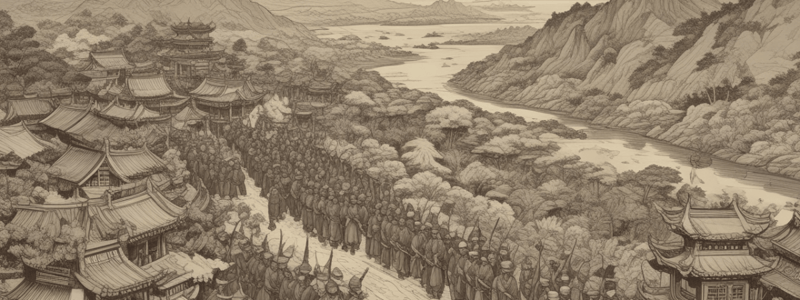Podcast
Questions and Answers
When were the Dutch and Spanish colonies established in Taiwan?
When were the Dutch and Spanish colonies established in Taiwan?
- In the 13th century
- In the 17th century (correct)
- In the 3rd century AD
- In prehistoric times
Which ethnic group was part of the Austronesian ethno-linguistic group in Taiwan?
Which ethnic group was part of the Austronesian ethno-linguistic group in Taiwan?
- Han Chinese
- Ketagalan (correct)
- Hakka
- Hoklo
Who defeated the Dutch and established a base of operations on Taiwan in 1662?
Who defeated the Dutch and established a base of operations on Taiwan in 1662?
- Koxinga (correct)
- The Spanish
- The Hoklo immigrants
- The Qing dynasty
Which dynasty annexed Taiwan after defeating Koxinga's descendants in 1683?
Which dynasty annexed Taiwan after defeating Koxinga's descendants in 1683?
What happened to Taiwan after the Qing dynasty lost the First Sino-Japanese War in 1895?
What happened to Taiwan after the Qing dynasty lost the First Sino-Japanese War in 1895?
Who won the 2024 presidential elections in Taiwan?
Who won the 2024 presidential elections in Taiwan?
Which political party ruled Taiwan as a single-party state for forty years?
Which political party ruled Taiwan as a single-party state for forty years?
Who declared martial law in Taiwan after losing control of mainland China?
Who declared martial law in Taiwan after losing control of mainland China?
What was the result of the 2022 legislative election in Taiwan?
What was the result of the 2022 legislative election in Taiwan?
When did the ROC government under the KMT withdraw to Taiwan?
When did the ROC government under the KMT withdraw to Taiwan?
Flashcards are hidden until you start studying
Study Notes
The history of Taiwan dates back to prehistoric times, with evidence of human habitation tens of thousands of years ago. The earliest known civilization on the island was the Ketagalan, an indigenous people who were part of the Austronesian ethno-linguistic group. Taiwan was first mentioned in Chinese records in the 3rd century AD, but it wasn't until the late 13th century that the ancestors of the Han Chinese began to settle on the island.
In the 17th century, the Dutch and Spanish established colonies in the south and north of the island, respectively. The Dutch colonized the south, while the Spanish built a settlement in the north. These European settlements were followed by an influx of Hoklo and Hakka immigrants from Fujian and Guangdong. In 1662, Koxinga, a Chinese general, defeated the Dutch and established a base of operations on the island. His descendants were defeated by the Qing dynasty in 1683, and their territory in Taiwan was annexed by the Qing dynasty.
Over the next two centuries, Qing rule increased the population of Taiwan to over two million, making it majority Han Chinese through illegal cross-strait migrations from the mainland. The Qing ceded Taiwan and Penghu to Japan after losing the First Sino-Japanese War in 1895. Taiwan experienced industrial growth and became a productive rice- and sugar-exporting Japanese colony. During the Second Sino-Japanese War, it served as a base for invasions of China, and later Southeast Asia and the Pacific during World War II.
In 1945, following the end of hostilities in World War II, the nationalist government of the Republic of China (ROC), led by the Kuomintang (KMT), took control of Taiwan. The legality and nature of its control of Taiwan, including transfer of sovereignty, is debated. In 1949, after losing control of mainland China in the Chinese Civil War, the ROC government under the KMT withdrew to Taiwan, where Chiang Kai-shek declared martial law. The KMT ruled Taiwan (along with the islands of Kinmen, Wuqiu and the Matsu) as a single-party state for forty years until democratic reforms in the 1980s.
In January 2020, Tsai Ing-wen was re-elected in the presidential election, and the Democratic Progressive Party (DPP) won majority 61 out of 113 seats in the parliamentary election. However, no party won a majority in the 2022 legislative election, meaning 51 seats for the Democratic Progressive Party (DPP), 52 seats for the Kuomintang (KMT), and the Taiwan People's Party (TPP) secured eight seats. In January 2024, William Lai Ching-te of the ruling Democratic Progressive Party won Taiwan’s presidential elections.
Studying That Suits You
Use AI to generate personalized quizzes and flashcards to suit your learning preferences.




